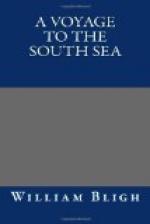May. Friday 9.
On the 9th of May at eight o’clock in the evening we were near the situation of Tristan da Cunha, our latitude being 37 degrees 7 minutes south and longitude 15 degrees 26 minutes west. All the afternoon the weather had been clear enough for land of a moderate height to be seen at least seven leagues; I therefore concluded that we had not yet passed the meridian of the island; for the most western position given to it from any authority is 15 degrees 0 minutes west.
As I wished to make this island we kept our wind on different tacks during the night, that we might be nearly in the same place at daylight in the morning as on the preceding evening: in the morning no land being in sight we continued to steer to the eastward.
Saturday 10.
We ran on all day having clear weather but without seeing anything to indicate our being near land. At noon our latitude observed was 37 degrees 27 minutes south which, being more to the southward than we had reason to expect, I altered the course to the northward and steered north-east all the afternoon. At six o’clock in the evening we were in latitude 37 degrees 0 minutes south and longitude 12 degrees 42 minutes west, having a clear horizon but not the least sign of being in the neighbourhood of land. With the night came thick rainy weather and we were now to the eastward of the situation ascribed to Tristan da Cunha; I therefore determined to give over the search and to resume our course towards the Cape of Good Hope.
The island of Tristan da Cunha, by Robertson’s Elements, is laid down in 37 degrees 12 minutes south latitude and 13 degrees 23 minutes west longitude. In Captain Cook’s general map, prefixed to his last voyage, it is placed in the same latitude but in 15 degrees west longitude. From our track and the clearness of the weather I am convinced, if the latitude ascribed to it as above is correct, that it is not to be found between the meridians of 16 degrees 30 minutes west and 12 degrees 30 minutes west. On the 13th I had a number of lunar observations for the longitude, the mean of which agreed exactly with the timekeeper.*
(Footnote. In Mr. Dalrymple’s Collection of Plans which I had not with me the northernmost of the Islands of Tristan d’Acunha is placed in latitude 37 degrees 22 minutes south and longitude 13 degrees 17 minutes west. I think it probable we missed them by being too much to the northward.)
In this passage the weather was generally so cloudy that I had few opportunities to make observations of any kind except for the noon latitudes. I could not determine when we crossed the line of no variation. The two nearest observations to it were: the first in 39 degrees 51 minutes south latitude and 26 degrees 11 minutes west longitude, where the variation of the compass was found to be 3 degrees 17 minutes east; and the other in latitude 35 degrees 30 minutes south and longitude 5 degrees 21 minutes west, where I observed the variation 11 degrees 35 minutes west; between these we had no intermediate observation for the variation.




